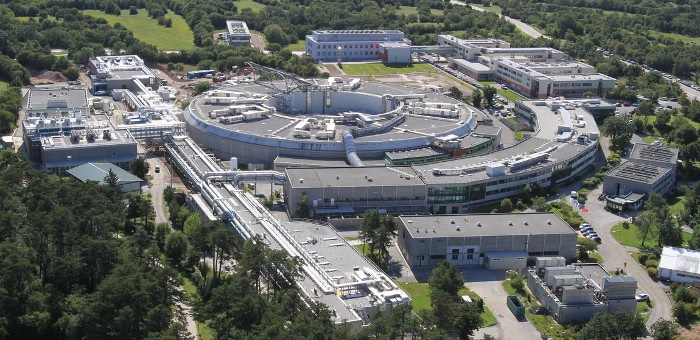2015/09/17
No Writer Credit

The superconducting current (red tubes) running in the interstitial space between puddles of electronic crystals. Credit: Alessandro Ricci/DESY
Using high-energy X-rays, an international team of scientists has discovered a surprising inner structure of a special class of superconductors: Within these so-called high-temperature superconductors, the electrons form puddles of varying sizes throughout the material. This finding helps to understand the microscopic origin of high-temperature superconductivity that is still not fully known. The team reports its observations in the journal Nature.
Superconductors are materials that can transport electric currents completely without loss. This feature makes them attractive for a wide spectrum of technical applications. Unfortunately, classic superconductors have to be cooled down to temperatures near absolute zero (minus 273,15 degrees Celsius) to work. This limits their application to a few special purposes. However, a couple of decades ago it was discovered that certain ceramics can become superconducting at much higher temperatures. Despite their name, these high-temperature superconductors still have to be cooled down, but not as much as classic superconductors. Some copper oxides (cuprates) can become superconducting at minus 170 degrees Celsius, for instance.
High-temperature superconductors work different from classic superconductors, and with a better understanding of their function, the design of a room temperature superconductor might become possible one day. To investigate the microstructure of a high-temperature cuprate superconductor (HgBa2CuO4+y), the team led by Alessandro Ricci of DESY, Antonio Bianconi of the Rome International Centre for Materials Science Superstripes (RICMASS) and Gaetano Campi of the Italian Council of National Research (CNR) looked at it with high-energy X-rays at DESYs synchrotron light source DORIS (beamline BW5), the Italian synchrotron Elettra and the European Synchrotron Radiation Source ESRF.
Here they used a special space resolved diffraction technique (called scanning micro X-ray diffraction) that allows to investigate the microscopic aggregation of electrons in small crystalline domains.
In conventional materials like metals and semiconductors, the electrons, carriers of the electric charge, move homogenous, like a liquid spreading out evenly in a canal. For many decades scientists believed that superconductivity also had to appear as a homogenous order in the material. By contrast, in the high-temperature cuprate superconductor investigated, the electrons start to aggregate and form puddles at minus 20 degrees Celsius already. „We discovered that the sizes of these puddles vary widely, like the chunks of a molten iceberg or the steam bubbles in a boiling pot“, explains Ricci. While the average puddle measures about 4 nanometres (millionths of a millimetre) across, puddles as large as 40 nanometres could be seen. The distribution of the puddle sizes can be described by a power-law which is typical for self-organisation.
The scientists could show that the puddles fill the whole material, leaving free interstitial space. Not all electrons become aggregated in these puddles. The electric current, which is carried by pairs of electrons that have remained free, has to flow around the puddles. As the authors found, the interstitial space between the puddles can be described by a special form of geometry: While the world around us usually follows the rules of Euclidean geometry, in the interstitial space of the high-temperature superconductor a hyperbolic geometry applies, as Ricci point out. „These results open new avenues for the design of superconducting materials, and thus could advance the search for a room temperature superconductor.“
The team consisted of scientists from DESY, RICMASS, CNR, ESRF, Elettra, the University of Twente in The Netherlands, the Queen Mary University of London, the Swiss Federal Institute of Technology, the Moscow State University and Ghent University in Belgium.
Reference:
„Inhomogeneity of charge-density-wave order and quenched disorder in a high-Tc superconductor“; G. Campi, A. Bianconi, A. Ricci et al.; Nature, 2015; DOI: 10.1038/nature14987
See the full article here .
Please help promote STEM in your local schools.

DESY is one of the world’s leading accelerator centres. Researchers use the large-scale facilities at DESY to explore the microcosm in all its variety – from the interactions of tiny elementary particles and the behaviour of new types of nanomaterials to biomolecular processes that are essential to life. The accelerators and detectors that DESY develops and builds are unique research tools. The facilities generate the world’s most intense X-ray light, accelerate particles to record energies and open completely new windows onto the universe. That makes DESY not only a magnet for more than 3000 guest researchers from over 40 countries every year, but also a coveted partner for national and international cooperations. Committed young researchers find an exciting interdisciplinary setting at DESY. The research centre offers specialized training for a large number of professions. DESY cooperates with industry and business to promote new technologies that will benefit society and encourage innovations. This also benefits the metropolitan regions of the two DESY locations, Hamburg and Zeuthen near Berlin.



